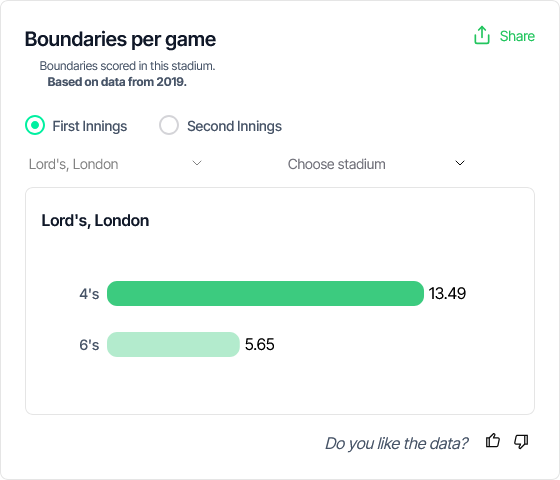When it comes to trading on T20 cricket, the margins between winning and losing can be as fine, as the fine print on a scam. That’s where venue-specific stats can make all the difference. One of the most overlooked yet incredibly useful data points for traders is boundary scoring trends.
Let’s take Lord’s, London as an example.
What the Boundary Data Says
Since 2019, matches at Lord’s have followed a fairly consistent scoring pattern:
| Innings | 4s per game | 6s per game |
|---|---|---|
| First | 13.49 | 5.65 |
| Second | 12.62 | 4.04 |
The data shows that teams batting first at Lord’s hit more boundaries—both fours and sixes—than those chasing. The drop is especially sharp in the number of sixes: nearly 30% fewer in the second innings.

Why This Matters for Traders
This insight opens up multiple trading angles:
- Total Match Sixes: If you know teams chasing at Lord’s are less likely to clear the ropes, you might want to trade under on total match sixes especially if strong bowlers are playing or you have great probabilities available!
- Innings-Specific Markets: Many sportsbooks offer over/under trade on boundaries per innings. The data suggests backing more boundaries in the first innings could be a profitable long-term play.
- Live Trading: If a team posts a solid total batting first and clears 10+ boundaries early, the market may overestimate how easy it will be to chase. That’s your moment to back the defending team at good probabilities.
Combine with Other Insights
Boundary data doesn’t exist in isolation. For example, data from Lord’s also shows:
- Winning Percentage: 61% of matches have been won by teams batting first.
- Run-scoring Trends: First-innings teams average 169; second-innings teams drop to 147.
- Death Over Performance: Runs fall steeply in the death overs for chasing sides.
Together, these patterns suggest Lord’s often gets tougher to bat on as the game progresses—something most casual traders miss.
How to Use This on Matchday
Let’s say Middlesex are playing Sussex at Lord’s. If Sussex bat first, you can reasonably expect them to hit more than 13 fours and 5–6 sixes, and potentially post around 170. That gives you benchmarks for boundary, team totals, and player over/under trades.

Meanwhile, if Middlesex chase, data suggests the boundaries will dry up, especially in the death overs. That could be a good time to trade against a successful chase, even if they look on track early.
Final Word: It’s About Edges
No stat guarantees a win—but over time, edges add up. Using venue-level boundary trends is one of the smartest ways to go from guessing to predicting.
For more data built for serious traders head to Spoda.ai.
Leave a Reply